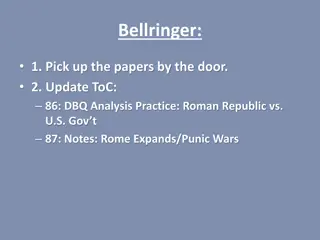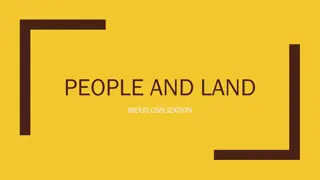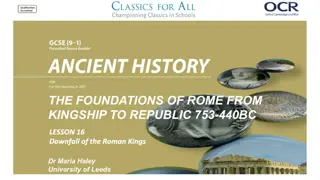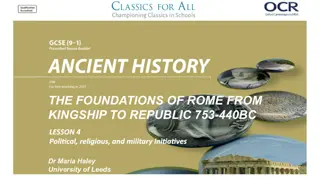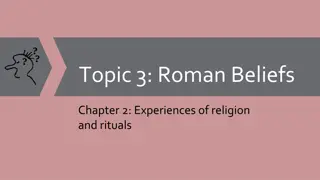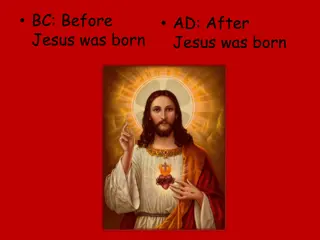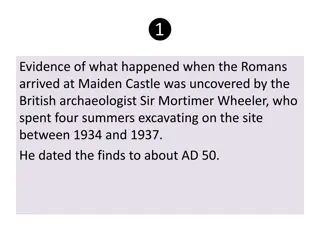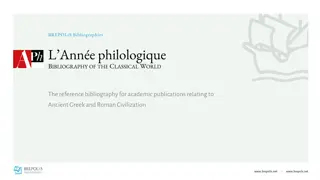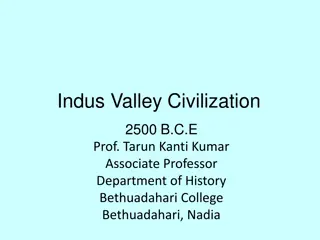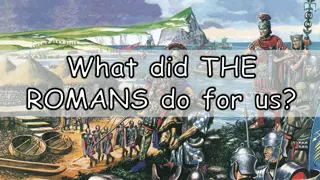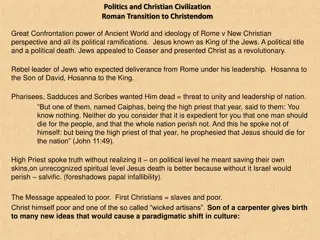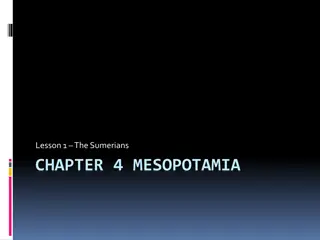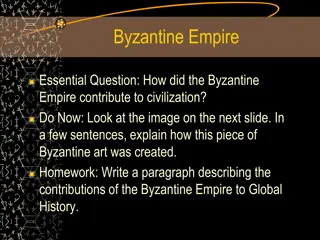Roman Civilization Overview
Roman civilization was influenced by Greek culture, as seen in their art, literature, and architecture. Roman artists and writers borrowed ideas from the Greeks but adapted them to suit their needs. They created realistic statues, innovative buildings with features like arches and domes, and iconic structures like the Colosseum and Pantheon. Roman literature flourished with works by Virgil, Horace, Ovid, Catullus, and Livy. Advancements in science and engineering, such as Galen's anatomical studies and the construction of aqueducts, also characterized Roman society. Daily life varied greatly between the wealthy, who lived in luxury, and the poor, who resided in cramped apartments.
Download Presentation

Please find below an Image/Link to download the presentation.
The content on the website is provided AS IS for your information and personal use only. It may not be sold, licensed, or shared on other websites without obtaining consent from the author.If you encounter any issues during the download, it is possible that the publisher has removed the file from their server.
You are allowed to download the files provided on this website for personal or commercial use, subject to the condition that they are used lawfully. All files are the property of their respective owners.
The content on the website is provided AS IS for your information and personal use only. It may not be sold, licensed, or shared on other websites without obtaining consent from the author.
E N D
Presentation Transcript
Roman Civilization Roman Civilization Patricia Vigil Yina Li Standards: 6.7.8 7.1.1, 2,3
ROMAN CULTURE ROMAN CULTURE Roman artists and writers borrowed many ideas from the Greeks. They admired and studied Greek statutes, buildings, and ideas. They copied many ideas, but changed things to meet their needs.
Roman Statues Statues were made to look realistic. People were shown with: Wrinkles Warts Less attractive Features
Buildings They used Greek- style porches and rows of columns called colonnades. But they also added their own features, such as arches, vaults, and domes. This made their buildings more open than any other buildings before their time. They also invented concrete - a mixture of volcanic ash, lime, and water Concrete made buildings sturdier and allowed them to be built taller.
The Roman Colosseum Completed about A.D. 80 Seated 60,000 people
Pantheon Built to honor Rome s gods Largest domed roof in it s time
Roman Literature Virgil- epic poem Aeneid Horace satires and odes Ovid- based on Greek myths Catullus- poems about love, sadness, and envy Livy- History of Rome - 10 B.C.
Roman Science and Engineering Galen- studied anatomy (the study of body structure) Ptolemy- scientist who studied the sky Engineers built a system of roads and bridges to connect the empire. They also used advanced engineering to build aqueducts that brought water from the hills into the cities.
Daily life in Rome The rich and the poor had very different lives. Wealthy Romans: -large, comfortable houses -fine furniture -beautiful gardens -inner court - atrium Poor Romans: -apartment buildings - stone and wood -high rent forced families to live in one room
Poverty Most people were poor. Roman apartments were up to six stories high. They often collapsed because they were so poorly built. Fire was also a constant danger. The city was crowded, noisy, and dirty. To keep the people from rioting, the government provided bread and circuses - free grain and shows.
Sports and Contests Sports were important to the Romans Events took place in the Colosseum, amphitheatres, and the Circus Maximus - wild beast fights - battles between ships - gladiator contests - chariot races These events attracted thousands of Roman spectators
Circus Maximus One of the largest arenas ever made Used for chariot races
Gladiators They were enslaved people, criminals, or poor people. They fought animals and each other. They were admired.
Slavery Public slaves: -owned by the state -took care of important buildings and served government officials Private slaves: -owned by individuals -forced to work long hours -could be sold at any time Spartacus- gladiator who led the slave revolt in 73 B.C.
Roman Religion They worshipped gods and goddesses, spirits, and emperors. Romans honored their gods and goddesses by praying and offering food. Every Roman home had an altar for their household gods.
Family Life Paterfamilias- father of the family They had complete control over family members. He punished children severely if they disobeyed. He also arranged their marriages.
Education Poor Romans could not afford to send their children to school. Wealthy Romans, however, hired tutors to teach their young children at home. Some older boys went to school and learned reading, writing, and rhetoric. Older girls did not go to school; they studied at home and learned household duties.
Becoming a Man Roman boys between the ages of 14-16 They would burn their toys for offerings to the household gods. Then they would put on a toga. Once they came of age, they would join the family business, become a soldier, or begin a career in the government.
Roman Women They became adults when they married. They usually wore a long flowing robe with a cloak called a palla.
The Decline of Rome Commodus son of Marcus Aurelius - became emperor in A.D. 180 after fathers death - cruel and wasted money - spent much of his time fighting as a gladiator - A.D. 182 he was killed by his bodyguard. Severans emperors who ruled after Commodus - worked toward putting down revolts - protecting Rome s borders - ignored growing problems of crime and poverty
Political and Social Problems The last Severan ruler died in A.D. 235 Rome s government became very weak. - Army leaders fought each other for the throne - Rome had 22 different emperors during this time - Fewer Romans honored the old ideals of duty, courage, and honesty - Many government officials took bribes
Economic and Military Problems During the A.D 200s, Rome s economy began to fall apart - Roman soldiers and invaders seized crops and destroyed fields. - Farmers grew less food, and hunger began to spread. - People bought fewer goods - Businesses closed - Workers had to leave jobs and serve in the army - A plague spread - Inflation
Invasion Germanic tribes raided Roman farms and towns Armies from Persia pushed into the empire s territories Fighting increased and the government could no longer pay Romans as soldiers The government started using Germanic warriors in the armies, but they were not loyal to Rome.
Diocletian Diocletian became emperor in A.D. 284 - He divided the empire into four parts - Tetrarchy - To slow inflation, he issued rules that set the prices of goods and the wages to be paid to workers - He ordered workers to remain at the same jobs until they died He retired from office in A.D. 305
Constantine Constantine became emperor in A.D. 312 To aid the economy, he issued several orders: - The sons of workers had to follow their fathers trades -The sons of farmers had to work the land their fathers worked - The sons of soldiers had to serve in the army
Constantine He moved the capitol from Rome to Byzantium The city became known as Constantinople
Theodosius After Constantine died in A.D. 337, fighting broke out again. Theodosius gained control and ended the fighting. A.D. 395- the Roman Empire split into two separate empires
Different Germanic groups existed: Ostrogoths, Visigoths, Franks, Vandals, Angles, Saxons They came from the forests and marshes of northern Europe They were looking for warmer climates and better grazing land for their cattle Some were drawn by Rome s wealth and culture Some were fleeing the Huns (warriors from Mongolia)
In the late A.D. 300s, the Huns entered Eastern Europe and defeated the Ostrogoths. The Visigoths feared they would be next so they asked the Eastern Roman emperor for protection. Trouble broke out between the Visigoths and Romans. -Visigoths forced to buy food at very high prices. - Romans also kidnapped and enslaved many Visigoths
Visigoths rebelled, in A.D. 378 they defeated Roman legions at the Battle of Adrianople. Rome was forced to surrender land to the Visigoths. More and more Germanic warriors crossed the borders in search of land In the winter of A.D. 406, the Rhine River in Western Europe froze Germanic groups crossed the frozen river and entered Gaul The Romans were too weak to force them back
The Vandals overran Spain and northern Africa, and then they sailed to Italy. In A.D. 410 the Visigoth leader Alaric and his soldiers captured Rome itself. In A.D. 455 they entered Rome and spent 12 days stripping buildings of everything valuable and burning them. They burned records and looted the treasury. It was the first time Rome had been conquered in 800 years. Vandalism
Rome Falls By the mid A.D. 400s, several Germanic leaders held high posts in Rome s government and army In A.D. 476- Germanic general Odoacer took control and overthrew the western emperor, Romulus Augustulus. After Romulus Augustulus, no emperor ever again ruled from Rome. Historians use this event to mark the end of the Western Roman Empire.
Odoacer controlled Rome for almost 15 years Visigoths seized the city and killed him They set up a kingdom in Italy under their leader, Theodoric. Germanic kingdoms arose throughout Europe By A.D. 500, the Western Roman Empire had faded away! Eastern Roman Empire prospers and becomes the Byzantine Empire
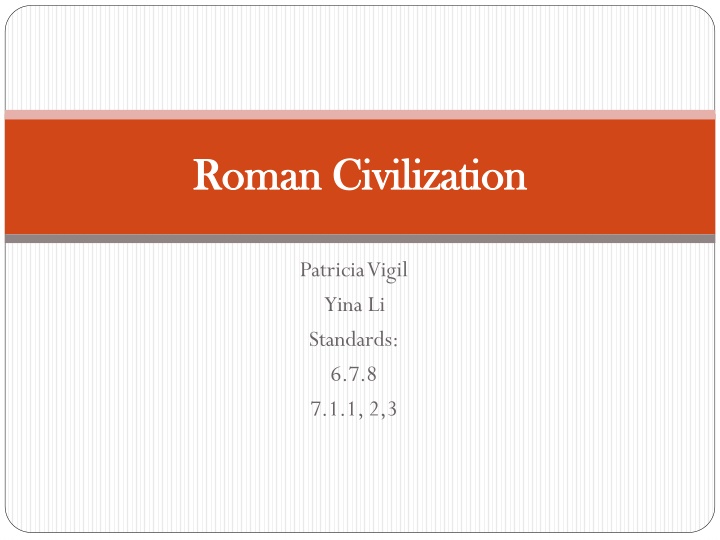

![Read⚡ebook✔[PDF] Blood of the Provinces: The Roman Auxila and the Making of Pro](/thumb/20539/read-ebook-pdf-blood-of-the-provinces-the-roman-auxila-and-the-making-of-pro.jpg)
![READ⚡[PDF]✔ European Mail Armour: Ringed Battle Shirts from the Iron Age, Roman](/thumb/20552/read-pdf-european-mail-armour-ringed-battle-shirts-from-the-iron-age-roman.jpg)

